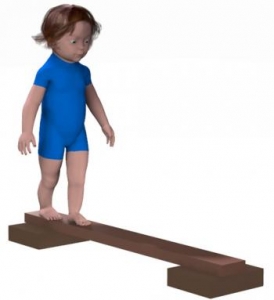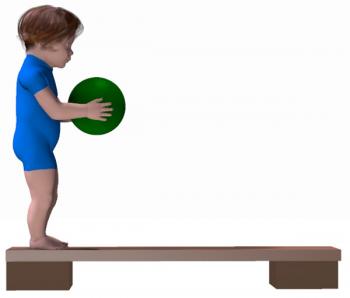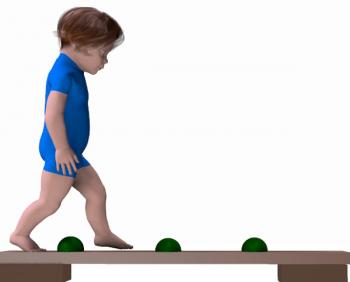Toddlers love the challenge of walking across a bridge and the experience they get walking on a narrow raised surface helps to develop a number of sub-skills:
- The toddler needs to make sense of visual information from two difference sources: the raised walking surface and the floor below. This helps the infant to make judgments about the height of a raised surface from the ground and whether it is safe to step or jump off a raised surface.
- Walking on a raised surface challenges the toddler's balance.
- Walking across a bridge also requires focused attention.
How to make a bridge
You will need:
- a 20 cm wide and 2 meters long plank
- 10 cm high box steps and 2 bathroom
- 4 pieces of non-slip matting.
Rest the plank on the steps to create a bridge. Put a piece of non-slip matting between the plank and the box step to stop it slipping sideways.
Start with a very low bridge
Make a low bridge using the 10 cm high box steps. You may want to put a non-slip mat under each box to stop them from slipping.
Encourage the child to step up onto the bridge at one end, and walk across to the other end, turn around and walk back again.

It is best that the child walks over the bridge without holding an adult's hand
When you hold a child's hand you automatically adjust the amount and direction of the support you provide - in other words you become an integral part of the child's balance responses.
If he is not willing to even try without holding on, let him hold onto one end of a rolled up small towel with you holding on the other end. This gives the child a sense that he is being supported, when in fact he is not.
Next make the bridge higher
Once you toddler will walk across the very low bridge, you can make a higher bridge using higher boxes or two small bathroom steps.
Carrying a ball or heavy bottle across the bridge
Once your toddler walks across the bridge easily and with confidence, you can make the game more challenging by getting him to carry objects across the bridge.

Stepping over obstacles on a bridge
Another way to make the task moe challenging is to position a few bean bags on your bridge.

Look around out of doors to find raised surfaces to walk on
It is important that te child is able to use this new ability in different environments. Look for low walls or logs in your garden or the local park. If the surface is narrow and high it is best to hold your child's hand for safety.
